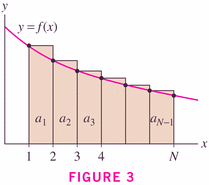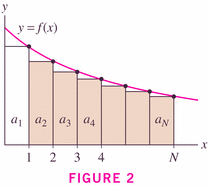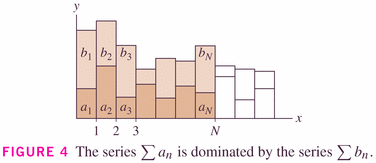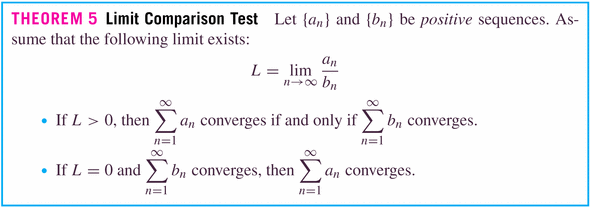- Your next exam is tomorrow, and will cover the sections we studied from 7.2 to 11.1
- 7.2 - trig integrals
- 7.7 - approximate integration
- 7.8 - improper integrals
- 8.1 - arc length
- 10.1 - parametric equations
- 10.2 - calculus with parametric curves
- 10.3 - polar coordinates
- 10.4 - area and arc length of polar curves
- 11.1 - sequences
- concerns several different means of testing for convergence of
series with all positive terms (obviously, if we're dealing with series
of all negative terms, similar results are going to apply).
- We're not so concerned with the actual limits (that is the values
of the series) as we are with the convergence (or divergence) of the
series.
- Theorems:




Theorem 3 is just a corollary of Theorem 2, where the integrals are the obvious power functions:

Let
, where f is a positive, decreasing function. If
converges by the integral test, and we define the remainder by
, then
(this gives us a bound on the error we're making in the calculation of a series). This is useful, for example, in the calculation of digits of
(now, you might ask "and what's the use of that?!";).
We can use this remainder inequality to get a bound on the true value of the series, just by adding
to each part of the inequality:
- Examples:
- We can use this method to demonstrate conclusively that the harmonic series is non-convergent.
- Dominoes (here's my page) -- and here's a more elegant page in Mathematica: Divergence of the harmonic series (and dominoes!)
- #22
- #36
- Theorems:

- if the series of the
if finite, so is the smaller series of
;
- if the series of the
if infinite, so is the larger series of
.

- geometric series, and
- p series, including
- the harmonic series (to show divergence).

This theorem says that, in the long run, one series has terms which are simply a constant times the terms in the other series.
In "the long run" means that we only really need to worry about the "tails" of series: we can throw away any finite number of terms for issues of convergence.
- if the series of the
- Examples:
- #6, p. 750
- #16
- #28
- #34 (draw a picture)
- #46